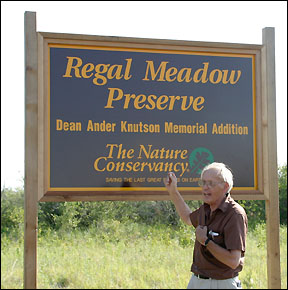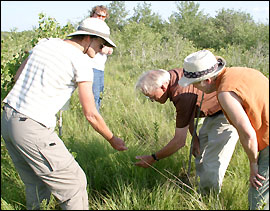110 acres of prarie donated to Regal Meadow
 With these words, Don Knutson, calling himself "a most reluctant conscript" to the group of people who have protected 110 acres of land west of Regal, passed on that land at a dedication ceremony last Thursday. The prairie, one of very few remaining parcels of wet to wet-mesic prairie, was donated by Knutson to The Nature Conservancy, and it is now one of three areas of land in the Regal Meadow Preserve, which covers a total of about 620 acres.
With these words, Don Knutson, calling himself "a most reluctant conscript" to the group of people who have protected 110 acres of land west of Regal, passed on that land at a dedication ceremony last Thursday. The prairie, one of very few remaining parcels of wet to wet-mesic prairie, was donated by Knutson to The Nature Conservancy, and it is now one of three areas of land in the Regal Meadow Preserve, which covers a total of about 620 acres.
Only a few years after a surprise twist in life ordained him the owner of 110 acres of rare prairie west of Regal, Don Knutson of Minneapolis donated that land to The Nature Conservancy. Knutson spoke last week, when the land was dedicated to the Regal Meadow Preserve in honor of his son, Dean Anders Knutson.
Knutson donated the land in memory of his son, Dean Anders Knutson, who died in 1997 and who Knutson described as "a wonderful man, full of vitality," who would have liked seeing the land and having it donated.
Grazing and fire created good natural disturbances to the prairie in the past, and it has never been plowed. "You can't rebuild this. It's a genuine native stand," said John Maile, the project manager of the Ordway/Glacial Lakes Project, of which the Regal Meadow is a part.
There are "a whole suite of plants associated" with wet prairie, according to Carmen Converse, the "plant lady" and program director of the Minnesota Department of Natural Resources' County Biological Survey. Some examples are cord grass, blazing star, prairie anemone, and heartleaf golden alexander.
In the floodplain of the Crow River, the Regal Meadow is also home to the small white lady's slipper as well as non-plant life, like the regal frittilary - coincidentally named that way - and the Poweshiek skipper, both species of butterflies.
Knutson, who grew up on a farm near Princeton, was "just so interested in plants and birds and frogs," he remembers. Now that farm has been given back to nature and is being taken over by cattails, deer, and other natural things. "You get addicted to things," he said of his interest in conservation.
However, Knutson mentioned, "I particularly loved trees. It was only later that I learned to appreciate prairie." Through an unusual series of events, he became the catalyst for the donation of this special piece of land, with its hundreds of species, many of them unique.
While he taught a botany class at the University of Minnesota, Twin Cities campus, he was approached by a student who said she and her husband owned a piece of prairie land and wanted him to look at it, to see if it was thriving. Though prairies were not his specialty, he came and discovered it to be thriving prairise.
After Knutson recommended that the couple contact The Nature Conservancy if they ever wanted it to become publicly protected land, he did not hear from them for ten years. Then the former student contacted him. She wanted to give him the land to take care of and to "keep it as a living, vital, natural prairie system," according to Knutson.
After owning the land for a couple of years, two years ago he began the process of shifting the land from private to public ownership, to make sure that it was protected while he was "still in shape to do it."
 The Nature Conservancy is a nonprofit national and international organization that works to preserve biodiversity of plants, animals, and natural habitats. In 1958, a chapter was started to protect land in Minnesota and the Dakotas, and in the nearly five decades since, that chapter has helped protect nearly half a million acres of land.
The Nature Conservancy is a nonprofit national and international organization that works to preserve biodiversity of plants, animals, and natural habitats. In 1958, a chapter was started to protect land in Minnesota and the Dakotas, and in the nearly five decades since, that chapter has helped protect nearly half a million acres of land.
Carmen Converse of the Minnesota DNR, donor Don Knutson, and Erna Engstrom - who, with her husband, owns a private reserve south of Sunburg - examine plants on a prairie given by Knutson to the Regal Meadow.
Sometimes the organization becomes the owner of land, but, more often, it helps protect it through work with private owners. Beginning in 1979, the Regal Meadow Preserve was acquired in stages through work with a number of different owners.
The Nature Conservancy, which also collects data for conservationists, hunters, or other interested parties, would like to see the land between the three areas of the Regal Meadow Preserve protected in some way, to keep the habitat contiguous.
Hunters did not run out of luck when this land switched hands, because it will be well-protected and can still be hunted. Other areas of the Regal Meadow are not open to hunting, but because this land has been hunted regularly, The Nature Conservancy will allow that to continue.
In fact, community members can recreate in other ways, such as bird-watching, said Maile. The land, which is located about a half-mile west of Regal on Highway 55, is open to the public.
Even with the land now protected, there is work to be done there, so the conservationists will be spending time on the "meat and potatoes of a preserve," as Maile termed it. Sparks - mostly from trains, as the land is bordered by a railroad track and trains used to have poor spark protection - started fires on the land every year to five years in the past, he noted, but the last time it had a significant burn was 1988.
Burning the land will reduce the "woody vegetation" which covers about 50 percent of the land, though it should only be living on about 25 percent. Aspen and willow trees are especially "encroaching into the prairie," Maile added, because no natural fires stop them. The land is too wet for controlled grazing, but if fire is found to be inappropriate for the land, brush will be cut in the winter when the land is frozen.
The imbalance caused by the lack of fire will be remedied, though, and the prairie - which is "the most threatened ecosystem on the planet," as indicated by Ron Nargang, state director of Minnesota's chapter of The Nature Conservancy - will be taken care of. Converse explained that the habitat is so rare because it is on "some of the richest soil in the world, literally. It's no surprise that humans have killed it."
Knutson, who "really didn't intend to own it," recognized the prairie as what he called "an ancient system," appreciated its beauty and uniqueness, and ensured its protection for use by community members now and into the future.
Contact the author at editor@paynesvillepress.com • Return to News Menu
Home | Marketplace | Community